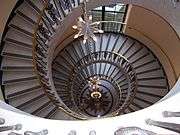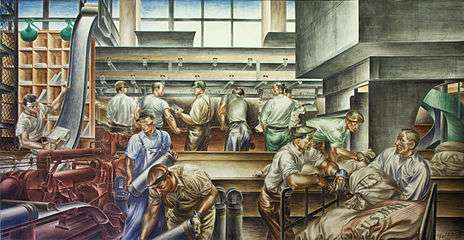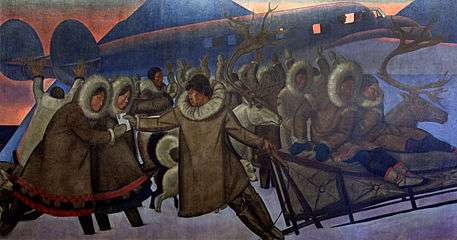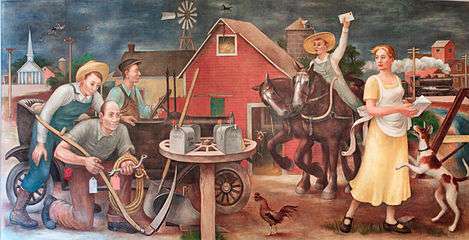William Jefferson Clinton Federal Building
|
William Jefferson Clinton Federal Building | |
|
The Clinton Building. The tower of the Old Post Office can be glimpsed in the background. | |
  | |
| Location |
12th Street, and Pennsylvania Avenue, NW Washington, D.C. |
|---|---|
| Coordinates | 38°53′38.04″N 77°1′44.04″W / 38.8939000°N 77.0289000°WCoordinates: 38°53′38.04″N 77°1′44.04″W / 38.8939000°N 77.0289000°W |
| Built | 1934 |
| Architect | William Adams Delano, Chester Holmes Aldrich |
| Architectural style | Classical Revival |
| Part of | Pennsylvania Avenue National Historic Site (#66000865[1]) |
The William Jefferson Clinton Federal Building is located in the Federal Triangle in Washington, D.C., across 12th Street from the Old Post Office. The New Post Office, as the Clinton Building was originally known, housed the headquarters of the Post Office Department until that department was replaced by the United States Postal Service in 1971. The building, which now houses the headquarters of the U.S. Environmental Protection Agency, was first renamed the Ariel Rios Federal Building on February 5, 1985, in honor of Ariel Rios, an undercover special agent for the Bureau of Alcohol, Tobacco, Firearms and Explosives who was killed in the line of duty on December 2, 1982. After the federal government announced that it would be renaming the building again in honor of former President Bill Clinton on May 13, 2013,[2] the building was officially renamed to its current title, the William Jefferson Clinton Federal Building, at a ceremony that took place July 17, 2013.[3]
History




The Clinton Building was constructed in the early 1930s as part of the redevelopment of the Federal Triangle area. At that time one of the city's most blighted neighborhoods, this area was known as Murder Bay and was a center of crime and prostitution.[4] The plan for the area's redevelopment was laid out as part of the 1901 McMillan Plan, the first federally funded urban redevelopment plan, and the redevelopment of Federal Triangle began in earnest in the 1930s under the leadership of Treasury Secretary Andrew W. Mellon. Construction on the Clinton Building was completed in 1934.
The Clinton Building was a central feature of the redevelopment. The neoclassical building was designed by architects William Adams Delano and Chester Holmes Aldrich, who took as their inspiration the Place Vendôme in Paris. The central section of the tri-unit building consists of two huge, back to back, semicircular units with side wings. The semicircle formed by the building's curve on its eastern façade was to be mirrored by a similarly curved façade built across 12th Street on the site of the Old Post Office Building.
Secretary Mellon's building commission actively sought the demolition of the Old Post Office to fulfill that plan, but preservation efforts—which continued over the course of 50 years—saved the Old Post Office. The second half of the grand plaza was never finished as designed, save for a curve in the northwest corner of the headquarters of the Internal Revenue Service. (The Ronald Reagan Building, completed in 1998, does mirror, to some degree, the semicircle of the west façade of the Clinton Building.)
The exterior is decorated with bas relief panels, by Adolph Alexander Weinman.[5]
The Clinton Building has been refurbished with the architectural details of the hallways preserved in the style of the 1920s and 1930s. A seven-story marble spiral staircase is a prominent element of the building's interior. A chandelier hangs in the center of the staircase and has exposed bulbs to illuminate each floor. It terminates in a dramatic chrome and brass globe.
In December 2012, both houses of Congress unanimously voted to rename the Rios Building as the William Jefferson Clinton Federal Building, after Bill Clinton, the 42nd president.[6] The General Services Administration administratively renamed the building for Clinton on May 13, 2013. The structure was formally dedicated at a ceremony on July 17, 2013, at which Clinton spoke and former EPA Administratrix Carol Browner attended. The Rios family approved of renaming a building. A reflecting pool at the new ATF headquarters on New York Avenue NW was named for Rios.[7]
Murals
The Clinton Federal Building was one of the initial locations that integrated various WPA murals that were originally commissioned and displayed in federally constructed buildings during the 1930s and 1940s. 25 murals were chosen and six have been criticized by visitors and employees as to stereotyping American Indians and integrating inappropriate images.[8][9]
The General Services Administration addressed the controversy:
"The U.S. Post Office headquarters murals embody many admirable qualities of American art and culture in the 1930s: a range of visual styles, inventive approaches to subject matter, commitment to bringing creativity and artistic beauty to public spaces, and devotion to the development of American art as a part of national identity. At the same time, engrained cultural attitudes of the 1930s are inevitably present, including stereotypes about women, Native Americans, African Americans, and rural Americans. From Ward Lockwood and Karl Free's depictions of Native Americans and African Americans as subservient to white colonists, to William Palmer and Frank Mechau's emphasis on the aggression of Native Americans and the passive victimhood of women, to Doris Lee's romanticized views of farm life during the Depression, the murals perpetuate outmoded views of their era. Today, the presence of the murals in this building offers a rare opportunity to experience a full cycle of New Deal artwork in its original context, and serves as a valuable reminder of how American society has changed over time".[8]
Controversy over WPA murals was prevalent during their installation and afterward. Nudity [10] and revolutionary sentiments implicit in some murals led to an extended public debate.[11]
Gallery
 Sorting the Mail (1936) by Reginald Marsh
Sorting the Mail (1936) by Reginald Marsh Unloading the Mail (1936) by Reginald Marsh
Unloading the Mail (1936) by Reginald Marsh Transportation of the Mail (1937) by Alfredo Crimi
Transportation of the Mail (1937) by Alfredo Crimi Post Office Work Room (1937) by Alfredo Crimi
Post Office Work Room (1937) by Alfredo Crimi Mail Service in the Arctic (1937) by Rockwell Kent
Mail Service in the Arctic (1937) by Rockwell Kent Mail Service in the Tropics (1937) by Rockwell Kent
Mail Service in the Tropics (1937) by Rockwell Kent General Store and Post Office (1938) by Doris Lee
General Store and Post Office (1938) by Doris Lee Country Post (1938) by Doris Lee
Country Post (1938) by Doris Lee
Renovation
In 1993, the building was renovated.[5][12][13] In 1998, the limestone facade was renovated.[14][15] In 2007, the south courtyard was renovated.[16]
References
- ↑ National Park Service (2008-04-15). "National Register Information System". National Register of Historic Places. National Park Service.
- ↑ "GSA Renaming D.C. Building After Former President." Washington Business Journal. May 13, 2013. Accessed 2013-05-13.
- ↑ Volcovici, Valerie (July 17, 2013). "EPA renames headquarters after former President Clinton". Reuters. Retrieved 2015-06-18.
- ↑ "Ariel Rios Building, Washington, D.C.". (General Services Administration official site). Retrieved May 18, 2008.
- 1 2 "Ariel Rios Federal Building (New Post Office), Washington, DC". gsa.gov. Retrieved 7 March 2015.
- ↑ The legislation is Public Law 112-237 (S. 3687, 112th Cong., 2d sess.). It also renamed the George Mahon Federal Building in Lubbock, Texas, the "George H.W. Bush and George W. Bush United States Courthouse and George Mahon Federal Building", and renamed Federal Office Building 8 in Washington, D.C., as the "Thomas P. O'Neill, Jr. Federal Building".
- ↑ Fears, Darryl. "EPA Headquarters Renamed in Honor of Bill Clinton." Washington Post. July 17, 2013, accessed 2013-07-018; "ATF to Name Reflecting Pool in Honor of Special Agent Ariel Rios." Press release. Bureau of Alcohol, Tobacco, Firearms, and Explosives. United States Department of Justice. July 16, 2013, accessed 2013-07-018.
- 1 2 "Where's the Art". General Services Administration. Retrieved 2015-06-09.
- ↑ "Ariel Rios Murals". General Services Administration. February 14, 2007. Archived from the original on March 15, 2007. Retrieved 2015-06-09.
- ↑ Fern Shen, "History and the EPA's Big Picture; '30s Mural Draws Stares and Criticism", Washington Post, November 10, 2005, at A01. Retrieved May 18, 2008.
- ↑ "Rockwell Kent". General Services Administration. Retrieved 2015-06-09.
Relying on his familiarity with Alaskan culture, Kent painted text in the little-known Kuskokwim dialect, creating a fictional message sent from Alaska to Puerto Rico. Translated, it reads: 'To the people of Puerto Rico, our friends! Go ahead, let us change chiefs. That alone can make us equal and free.' The implication of revolutionary sentiments angered groups of both American and Alaskan viewers. In Puerto Rico, some viewers objected to the inclusion of only dark-skinned figures.
- ↑ "Archived copy". Archived from the original on 2012-04-03. Retrieved 2011-11-10.
- ↑ "ARCADIS US - Ariel Rios Federal Building". arcadis-us.com. Retrieved 7 March 2015.
- ↑ "Archived copy". Archived from the original on 2012-05-02. Retrieved 2011-11-10.
- ↑ "Ariel Rios Building". lortonstone.com. Retrieved 7 March 2015.
- ↑ "EPA Headquarters Low Impact Development Demonstration Projects – William Jefferson Clinton Building South Courtyard". epa.gov. Retrieved 7 March 2015.
External links
- Murals at Clinton Federal Building
- "William Jefferson Clinton Building, Washington, D.C." (official General Services Administration site)
